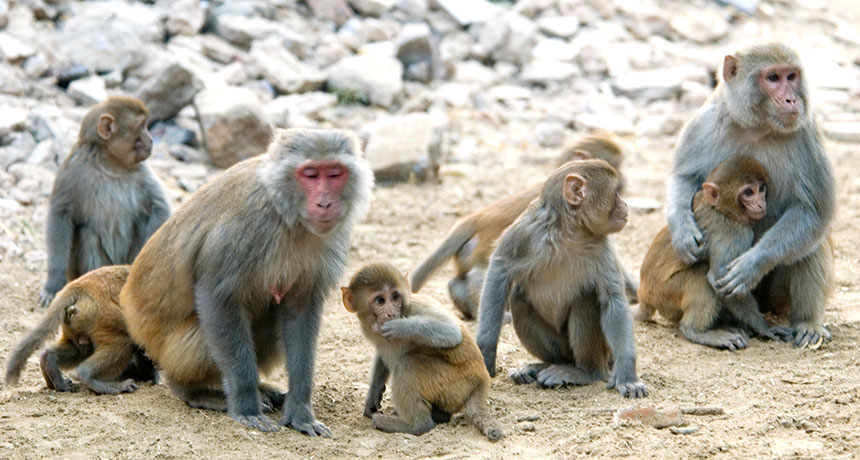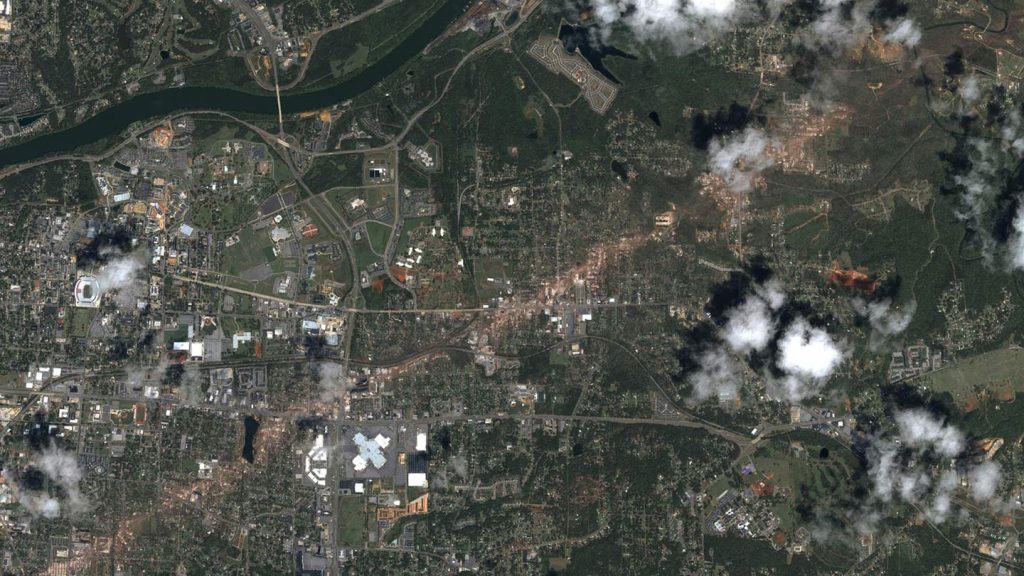The ecosystem that controls a galaxy’s future is coming into focus

There’s more to a galaxy than meets the eye. Galaxies’ bright stars seem to spiral serenely against the dark backdrop of space. But a more careful look reveals a whole lot of mayhem.
“Galaxies are just like you and me,” Jessica Werk, an astronomer at the University of Washington in Seattle, said in January at a meeting of the American Astronomical Society. “They live their lives in a constant state of turmoil.”
Much of that turmoil takes place in a huge, complicated setting called the circumgalactic medium, or CGM. This vast, roiling cloud of dust and gas is a galaxy’s fuel source, waste dump and recycling center all in one. Astronomers think the answers to some of the most pressing galactic mysteries — how galaxies keep forming new stars for billions of years, why star formation abruptly stops — are hidden in a galaxy’s enveloping CGM.
“To understand the galaxies, you have to understand the ecosystem that they’re in,” says astronomer Molly Peeples of the Space Telescope Science Institute in Baltimore.
Yet this galactic atmosphere is so diffuse that it’s invisible — a liter of CGM contains just a single atom. It has taken almost 60 years and an upgrade to the Hubble Space Telescope just to begin probing distant CGMs and figuring out how their constant churning can make or break galaxies.
“Only recently have we been able to really, truly, observationally characterize the relationship between this gaseous cycle and the properties of the galaxy itself,” Werk says.
Armed with the first extragalactic census, astronomers are now piecing together how a CGM controls its galaxy’s life and death. And new theoretical studies hint that galaxies’ stars would be arranged very differently without a medium’s frenetic flows. Plus, new observations show that some CGMs are surprisingly lumpy. A better understanding of CGMs, enabled by new telescopes and computer simulations, could change how scientists think about everything from galaxy collisions to the origins of our own atoms.
“The CGM is the part of the iceberg that’s under the water,” says astrophysicist Kevin Schawinski of ETH Zurich, who studies the more conventional parts of galaxies. “We now have good measurements where we’re sure it’s important.”
Waiting for Hubble
That 2009 Hubble telescope upgrade, which made the CGM census possible, almost didn’t happen.
In a cosmic coincidence, the Hubble telescope’s chief champions were also the first astronomers to figure out how to observe a galaxy’s CGM. Lyman Spitzer of Princeton University and John Bahcall of the Institute for Advanced Study in Princeton, N.J., and other astronomers noticed something strange after the 1963 discovery of quasars (SN Online: 3/21/14), bright beacons now known to be white-hot disks surrounding supermassive black holes in the centers of distant galaxies.
Everywhere astronomers looked, quasars’ spectra — the rainbow created when their light is spread out over all wavelengths — were notched with dark holes. Some wavelengths of light weren’t getting through.
In 1969, Spitzer and Bahcall realized what was going on: The missing light was absorbed by gas at the edges of galaxies, the same stuff that would later be called the CGM. Astronomers had been peering at quasars shining through CGMs like headlights through a fog.
Not much more could be done at the time, though. Earth’s atmosphere also absorbs light in those same wavelengths, making it difficult to tell which light-blocking atoms were in a galaxy’s CGM and which came from closer to home. Knowing that a CGM was there was one thing; taking its measurements would require something extra.
Spitzer and Bahcall knew what they needed: a space telescope that could observe from outside Earth’s atmosphere. The pair were two of the most vocal and consistent champions of the Hubble Space Telescope, which launched in 1990. Spitzer’s colleagues called him Hubble’s “intellectual and political father.”
Bahcall never stopped advocating for Hubble. In February 2005, six months before his death at age 70 from a rare blood disorder, he cowrote an article in the Los Angeles Times urging Congress to restore funding for a mission to fix some aging Hubble instruments, which NASA had canceled after the 2003 Columbia space shuttle disaster.
“What is at stake is not only a piece of stellar technology but our commitment to the most fundamental human quest: understanding the cosmos,” Bahcall and colleagues wrote. “Hubble’s most important discoveries could be in the future.”
His plea was answered: The space shuttle Atlantis brought astronauts to repair Hubble for the last time in May 2009 (SN Online: 5/19/09). During the repair, the astronauts installed the Cosmic Origins Spectrograph, which could pick up diffuse CGM gas with 30 times the sensitivity of any previous instrument. Although earlier spectrographs on Hubble had picked out CGMs a few quasar-beams at a time, the new device let astronomers search around dozens of galaxies, using the light of even dimmer quasars.
“It blew the field wide open,” Werk says.
The circumgalactic census
A team led by Jason Tumlinson of Baltimore’s Space Telescope Science Institute, Hubble’s academic home, made a catalog of 44 galaxies with a quasar sitting behind them from Hubble’s perspective. In a 2011 paper in Science, the researchers reported that every time they looked within 490,000 light-years of a galaxy, they saw spectra dappled with blank spots from atoms absorbing light. That meant that CGMs weren’t odd cloaks worn by just a few galaxies. They were everywhere.
Tumlinson’s team spent the first few years after Hubble’s upgrade like 19th century naturalists describing new species. The group measured the mass and the chemical makeup of the galaxies’ CGMs and found they were huge cisterns of heavy elements. CGMs contain 10 million times the mass of the sun in oxygen alone. In many cases, the mass of a CGM is comparable to the mass of the entire visible part of its galaxy.
The finding offers an answer to a long-standing cosmic mystery: How do galaxies have enough star-forming fuel to keep going for billions of years? Galaxies build stars from collapsing clouds of cool gas at a constant rate; the Milky Way, for example, makes one to two solar masses’ worth of stars every year. But there isn’t enough cool gas within the visible part of a galaxy, the disk containing its stars, to support observed rates of star formation.
“We think that gas probably comes from the CGM,” Werk says. “But exactly how that gas is getting into galaxies, where it gets in, the timescale on which it gets in, are there things that prevent it from getting in? Those are big questions that keep us all awake at night.”
Werk and Peeples realized that all that mass could help solve two other cosmic bookkeeping problems. All elements heavier than helium (which astronomers lump together as “metals”) are forged by nuclear fusion in the hearts of stars. When stars use up their fuel and explode as supernovas, they scatter those metals around to be folded into the next generation of stars.
But if you add up all the metals in the stars, gas and dust in a given galaxy’s disk, it’s not enough to account for all the metals the galaxy has ever made. The mismatch gets even worse if you include the hydrogen, helium, electrons and protons — basically all the ordinary matter that should have collected in the galaxy since the Big Bang. Astronomers call all those bits baryons. Galaxies seem to be missing 70 to 95 percent of that stuff.
So Peeples and Werk led a comprehensive effort to tally all the ordinary matter in about 40 galaxies observed with Hubble’s new spectrometer. The researchers published the results in two 2014 papers in the Astrophysical Journal.
At the time, Werk reported that at least half of galaxies’ missing ordinary matter can be accounted for in their CGMs. In a 2017 update, Werk and colleagues found that the mass of baryons just in the form of cool gas in a galaxy’s CGM could be nearly 90 billion solar masses. “Obviously, this mass could resolve the galactic missing baryons problem,” the team wrote.
“It’s a classic science story,” Schawinski says. The researchers had a hypothesis about where the missing material should be and made predictions. The group made observations to test those predictions and found what it sought.
In a separate study, Peeples showed that although metals are born in galaxies’ starry disks, those metals don’t stay there. Only 20 to 25 percent of the metals a galaxy has ever produced remains in the stars, gas and dust in the disk, where the metals can be incorporated into new stars and planets. The rest probably ends up in the CGM.
“If you look at all the metals the galaxies ever produced in their whole lifetime, more of them are outside the galaxy than are still inside the galaxy,” Tumlinson says, “which was a huge shock.”
Recycling centers
So how did the metals get into the CGM? Quasars’ spectra couldn’t help with that question. Their light shows only a slice through a single galaxy at a single moment in time. But astronomers can track galaxies’ growth and development with computer simulations based on physical rules for how stars and gas behave.
This strategy revealed the churning, ever-changing nature of gas in galaxies’ CGMs. Simulations such as EAGLE, or Evolution and Assembly of GaLaxies and their Environments, which is run out of Leiden University in the Netherlands, showed that metals can reach CGMs through stars’ violent lives: in powerful winds of radiation blowing away from massive young stars, and in the death throes of supernovas spraying metals far and wide.
Once the metals are in the CGM, though, they don’t always stay put. In simulations, galaxies seem to use the same gas over and over again.
“It’s basically just gravity,” Peeples says. “Throw a baseball up, and it’ll come back to the ground.” The same goes for gas flowing out of galaxies: Unless the gas travels fast enough to escape the galaxy’s gravity altogether, those atoms will eventually fall back into the disk — and form new stars.
Some simulations show discrete gas parcels making the trip from a galaxy’s disk out into the CGM and back again several times. Together, CGMs and their galaxies are giant recycling devices.
That means that the atoms that make up planets, plants and people may have taken several trips to circumgalactic space before becoming part of us. Over hundreds of millions of years, the atoms that eventually became part of you traveled hundreds of thousands of light-years.
“This is my favorite thing,” Tumlinson says. “At some point, your carbon, your oxygen, your nitrogen, your iron was out in intergalactic space.”
How galaxies die
But not all galaxies get their CGM gas back. Losing the gas could shut off star formation in a galaxy for good. No one knows how star formation shuts off, or quenches. But the answer is probably in the CGM.
Galaxies come in two main forms: young spiral galaxies that are making stars and old blobby galaxies where star formation is quenched (SN Online: 4/23/18).
“How galaxies quench and why they stay that way is one of the most important questions in galaxy formation generally,” Tumlinson says. “It just has to have something to do with the gas supply.”
One possibility, suggested in a paper posted online February 20 at arXiv.org, is that sprays of supernova-heated gas could get stripped from galaxies. Physicist Chad Bustard of the University of Wisconsin–Madison and colleagues simulated the Large Magellanic Cloud, a satellite galaxy of the Milky Way, and found that the small galaxy’s outflowing gas was swept away by the slight pressure of the galaxy’s movement around the Milky Way.
Alternatively, a dead galaxy’s CGM gas could be too hot to sink into the galaxy and form stars. If so, star-forming galaxies should have CGMs full of cold gas, and dead galaxies should be shrouded in hot gas. Hot gas would stay floating above the galactic disk like a hot air balloon, too buoyant to sink in and form stars.
But Hubble saw the opposite. Star-forming galaxies had CGMs chock-full of oxygen-VI — meaning that the gas was so hot (a million degrees Celsius or more) that oxygen atoms lost five of their original electrons. Dead galaxies had surprisingly little oxygen-VI.
“That was puzzling,” Tumlinson says. “If theory told us anything, it should have gone the other way.”
In 2016, Benjamin Oppenheimer, a computational astrophysicist at the University of Colorado Boulder, suggested a solution: The “dead” galaxies didn’t lack oxygen at all. The gas was just too hot for Hubble to observe. “In fact, there is even more oxygen around those passive galaxies,” Oppenheimer says.
All that hot gas could potentially explain why those galaxies died — except that these galaxies were full of star-forming cold gas, too.
“The dead galaxies have plenty of fuel left in the tank,” Tumlinson says. “We don’t know why they’re not using it. Everybody’s chasing that problem.”
Grabbing at the elephant
The chase comes at a good time. Until recently, observers had no way to map a single galaxy’s CGM. Researchers have had to add up dozens of quasar beams to understand the composition of CGMs on average.
“We’ve been like the three blind people grabbing at the elephant,” says John O’Meara, an observational astronomer at Saint Michael’s College in Colchester, Vt.
Teams using two new spectrographs — KCWI, the Keck Cosmic Web Imager on the Keck telescope in Hawaii, and MUSE, the Multi Unit Spectroscopic Explorer on the Very Large Telescope in Chile — are racing to change that. These instruments, called integral field spectrographs, can read spectra across a full galaxy all at once. Given enough background light, astronomers can now examine a single galaxy’s entire CGM. Finally, astronomers have a way to test theories of how gas circulates into and out of a galaxy.
A Chilean team, led by astronomer Sebastian Lopez of the University of Chile in Santiago and colleagues, used MUSE to observe a small dim galaxy that happens to be sandwiched between a bright, distant galaxy and a massive galaxy cluster closer to Earth. The cluster acts as a gravitational lens, distorting the image of the distant galaxy into a long bright arc (SN: 3/10/12, p. 4). The light from that arc filtered through the CGM of the sandwiched galaxy, which the team called G1, at 56 different points.
Surprisingly, G1’s CGM was lumpy, not smooth as expected, the team reported in the Feb. 22 Nature. “The assumption has been that that gas is distributed homogeneously around every system,” Lopez says. “This is not the case.”
O’Meara is leading a group that is hot on Lopez’s trail. Last year, while KCWI was being installed, O’Meara got an hour of observing time and was able to see hydrogen — which is associated with cool, star-forming gas — in the CGM of another galaxy backlit by a bright lensed arc. He’s not ready to discuss the results in detail yet, but the team is submitting a paper to Science.
Meanwhile, Peeples’ team is revisiting how computers render CGMs. “The resolution of the circumgalactic medium in simulations is, um, bad,” she says. Existing simulations are good at matching the visible properties of galaxies — their stars, the gas between the stars, and the overall shapes and sizes. But they “utterly fail at reproducing the properties of the circumgalactic medium,” she says.
So she’s running a new set of simulations called FOGGIE, which focus on CGMs for the first time. “We’re finding that it changes everything,” she says: The shape, star formation history and even the orientation of the galaxy in space look different.
Together, the new observations and simulations suggest that the CGM’s function in the life cycle of a galaxy has been underestimated. Theorists like Peeples and observers like O’Meara are working together to make new predictions about how the CGM should look. Then the researchers will check real galaxies to see if they match.
“Molly will post a really amazing new render of a simulation on Slack, and I’ll go, ‘Holy crap, that looks weird!’ ” O’Meara says. “I’ll go scampering off to find a similar example in the data, and we get into this positive feedback loop of going ‘Holy crap! Holy crap!’ ”
While future circumgalactic studies will focus on gathering spectra from full CGMs, Tumlinson is hoping to squeeze more information out of Hubble while he still can. Hubble made CGM studies possible, but the telescope is 28 years old, and probably has less than a decade left. Hubble’s spectrograph is still the best at observing certain atoms in CGMs to help reveal the gaseous halos’ secrets. “It’s something we definitely want to do,” he says, “before Hubble ends up in the ocean.”








